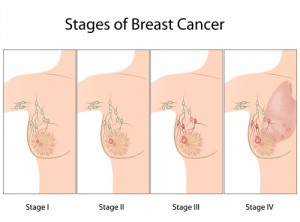 Once the biopsy is complete, a pathologist examines the report and notes observations depending on the cancer stage and tumor size. The stages of breast cancer distinguish whether the cancer is contained or malignant, meaning whether it is limited to the breast or the lymph nodes, or it has spread beyond the breast to other parts of the body. Cancer stages are marked by Roman letters, and range from 0, denoting a non-invasive and limited cancer, to IV, which is a highly aggressive and invasive cancer. Oncologists may use terms like ‘locally advanced’ or ‘regionally advanced’ to denote the nature of the cancer, changes in shape of the breast, lymph node elongation, and similar events.
Once the biopsy is complete, a pathologist examines the report and notes observations depending on the cancer stage and tumor size. The stages of breast cancer distinguish whether the cancer is contained or malignant, meaning whether it is limited to the breast or the lymph nodes, or it has spread beyond the breast to other parts of the body. Cancer stages are marked by Roman letters, and range from 0, denoting a non-invasive and limited cancer, to IV, which is a highly aggressive and invasive cancer. Oncologists may use terms like ‘locally advanced’ or ‘regionally advanced’ to denote the nature of the cancer, changes in shape of the breast, lymph node elongation, and similar events.
- Stage 0 refers to a non-invasive cancer, like ductal carcinoma in situ (DCIS), where there is not much evidence of cancer cells or non-cancerous but abnormal cells having moved beyond the part of the breast where they started, like the milk ducts.
- Stage I is used to denote invasive breast cancer, or a cancer that has spread to other breast tissue. This stage is further subdivided into IA and IB. IA refers to a mass of cancerous cells which have formed a tumor of not more than 2 cm and has not spread to the lymph nodes or outside of the breast. IB describes a cancer that appears as small groups of cells in the lymph nodes only, measuring from 0.2 mm to 2 mm, or a small tumor in the breast (less than or equal to 2 cm) plus evidence of small groups of cancer cells in the nearby lymph nodes.
- Stage II cancer is also divided into two categories. IIA denotes either a breast tumor that measures from 2 cm to 5 cm, or a smaller tumor (2 cm or less) in the breast, with cancer having spread to the axillary lymph nodes (lymph nodes found under the arm); or a cancer only in the lymph nodes but clearly involved there, meaning tumors larger than 2 mm found in 1 to 3 axillary lymph nodes or in lymph nodes near the breast. In Stage IIB, breast tumors are between 2 cm and 5 cm, and groups of cancer cells (0.2 mm to 2 mm in size) are also in the lymph nodes; or the cancer is limited to the breast but the tumor is larger than 5 cm.
- Stage III describes a more aggressive form of invasive breast cancer and is divided into three categories. Stage IIIA denotes cancer in 4 to 9 axillary lymph nodes or those near the breastbone, with either a tumor of any size in the breast or no tumor breast tumor at all; or, a breast tumor greater than 5 cm plus small groups of cancer cells in the lymph nodes. IIIB denotes a tumor of any size in the breast that also has spread to the chest wall or breast skin, causing ulcerations and swelling, and may also be in axillary lymph nodes or those near the breastbone. Finally, IIIC is an inflammatory cancer that is at least stage IIIB, with signs that may include redness, warmth and swelling of the breast or breast skin. This cancer may also involve 10 or more axillary lymph nodes, or lymph nodes near the collarbone or the breastbone.
- Stage IV marks a breast cancer that has spread beyond the breast and nearby lymph nodes to other organs: the lungs, liver, brain, distant lymph nodes, skin,or bones. It may also be called ‘advanced’ and ‘metastatic’ breast cancer. A stage IV cancer can be a first diagnosis, or it can be a metastatic recurrence of a previous cancer.
Another system used to stage, or distinguish, breast is called TNM. This system is based on three characteristics:
- Tumor size, denoted by the letter T. This is further classified as T1, T2, T3, and T4, based on tumor size and neighboring tissue involvement. Or it is classified as TX, a tumor that can’t be measured or found; or T0, meaning a primary tumor cannot be found.
- Lymph node involvement, denoted by N. Here, N0 means nearby nodes are clean, and NX means they can’t be measured or found. N1 through N3 ratings, on an increasing scale, describe the number of lymph nodes affected by the cancer and the amount of cancer in them.
- Metastasis, or evidence of cancer spread in the body, is denoted by the letter M. MX is metastasis that can’t be measured or found, M0 designates no distant metastasis, and M1 means evidence of distant metastasis.
Read about Breast Cancer treatments.
[adrotate group=”3″]
Note: Breast Cancer News is strictly a news and information website about the disease. It does not provide medical advice, diagnosis or treatment. This content is not intended to be a substitute for professional medical advice, diagnosis, or treatment. Always seek the advice of your physician or other qualified health provider with any questions you may have regarding a medical condition. Never disregard professional medical advice or delay in seeking it because of something you have read on this website.
